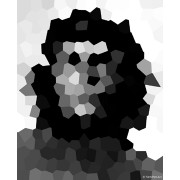Exhibition:Twentieth Century Boy
Artist:Nam HyoJun
Venue: HOTEL ANTEROOM KYOTO | GALLERY 9.5
http://hotel-anteroom.com/
reviewer:Yutaro Midorikawa, Art Critic
『「死んでる人」』
「何にも役に立たないものだけが真に美しいのである。」 -ゴーティエ 『モーパン嬢』序文
Nam HyoJunは、真に美しいものを描いています。死者です。死人に口無し。死者は何にも役に立ちません。死は生にとって埒外であり、理解を超えたわからなさそのものです。ではその死を彼はどう捉えているのでしょうか。
それは今回のオープニングトークでの彼の一言に集約されていると考えられます。展示されている絵の人物を彼は、「死んでる人」と呼びました。ガンジー、ヒトラー、ゲバラ。本展 『トゥエンティー・センチュリー・ボーイ』で描かれた人物は確かにみな死んでる人たちです。しかしこの言い方には不自然なところがあります。「死んでる人」。いかがでしょう。彼らを私たちであれば「死んだ人」というのが自然なのではないでしょうか。では「死んだ人」と「死んでる人」はどう違うのでしょうか。
「死んだ人」は既に過去に回収されてしまって、決して戻ってこない人です。こちらの現実とは一切関係がない。一方「死んでる人」は死に続けている、あるいは死者という仕方で生き続けている特異な人といえるでしょう。「死んでる人」は確かに死んだかもしれないが、別の次元で生きている人です。多かれ少なかれこちらの現実とまだ関係がある。「死んだ人」は終わり、忘れ去られるが、「死んでる人」は終わらず、忘れ去られることがない。つまり、Nam HyoJunは終わらない死者を描いている。では、「死んでる人」の絵はいったい何を意味しているのでしょう。
おそらくナムはここで、終わらない死の空間を描いているのでしょう。人物と背景の距離感をモザイクで均一化し、私たちに馴染みのある生の空間とは違う場所、終わらない死の空間を彼は私たちに開いている。誰もが「死んでる人」になれるとは限りません。この世界にとって重要な意味を残した者だけが「死んでる人」になります。あるいはナムは死んでる人になろうとしているのかもしれません。死に続ける世界。それは真に無用で真に美しい世界です。あなたはそこに何が見えますか?
‘Dying person’
“Nothing is truly beautiful except that which is useless”
– Théophile Gautier, Mademoiselle de Maupin, 1835
Nam HyoJun paints the truly beautiful, the dead. Dead men tell no tale and serve to nothing. Death sits outside life and totally exceeds our comprehension.
HyoJun’s opening speech provides insight into how he understands and presents death. The subjects in his paintings are called the dying person. He presents Gandhi, Hitler, Guevara, and so on in an obscured mosaic. While it is true that all the subjects in Twentieth Century Boy are deceased, there is something unnatural, unnerving to the expression dying person. Isn’t it more natural to call the subjects dead people? HyoJun shows us that the dead person differs greatly from a dying person. HyoJun’s dying people continue to wreathing in and out of reality after death as a peculiar entity whose infamy maintains life, the dying are living in another dimension, having currency within our daily reality. A dead person ceases to exist, and they are collected in the past. HyoJun’s dying person represents a life that never ends.
HyoJun paints the unknown, the never-ending space after death. Creating a sense of distance with mosaic, distorting the subject from the foreground. With this technique he opens us to expanse of death, different from the space of life familiar to us.
Not everyone could be called a dying person after death, only the person who left significant meaning to this world would gain the title. Could HyoJun possibly hope to become one of the subjects he creates? The world of dying people, utterly useless and beautiful. What do you see?
